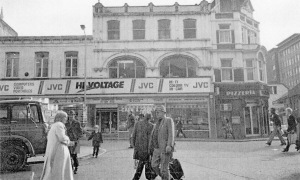POKE 35899, 0
 Of course, it was all different back then.
Of course, it was all different back then.
Audiovisual entertainment came in the form of three TV channels, a VHS video recorder (if you were lucky) or a Betamax (if you weren’t). Video games were the sole province of the seaside arcades or the bi-annual visits of The Mitcham Fair, or the occasional Galaxian machine lurking in a corner of HR Cloake’s record shop.
Otherwise it was a case of trying to emulate the thrills of the arcades on an LED screen embedded into a chunk of plastic the size of a telephone, or digging out the 1970s Binatone box from under the stairs to play a handful of variants on Pong.
That all changed in 1982. Sir Clive Sinclair, a doyen of the tinkerer market, made the leap into commercial success with the ZX Spectrum, the first colour computer to retail for under £200. Fooling approximately nobody with its educational credentials, it swiftly established itself as a game platform. And quickly too – by the end of 1982, there was a vast range of software available covering not only every extant arcade game, but several completely original gems.
Croydon’s High Street was not long in realising the massive commercial potential in these new toys. In the site of the former Salisbury Handbags shop in the North End, Vision Store gradually shifted their core business from TVs and Stereos to computers and computer games. They expanded to a second store shortly after – Hi Voltage, taking over the lease of a dying music shop on the corner of Mint Walk.
Everyone else, from WH Smiths to Lasky’s, swiftly got in on the act and gradually, a landscape emerged. If you wanted to check out the newer hardware such as Atari 600XL or the Memotech, you’d go to Lasky’s, where you could also have a go at programming without being disturbed. Mr Cad, the camera shop in the Whitgift, had a habit of investing in bonkers, unsalable devices like the TI99 4/a or the VTX5000 modem for the Spectrum. If you were saddled with a BBC or a Dragon 32, it was off to the top floor of Allders.
But it was Vision Store that always had the newest games before anyone else and it was there that you’d organise swaps and take your first tentative steps into the world of software piracy. You’d see the same faces there each week and after a while, you’d start making deals: you buy Scuba Dive and I’ll get Jet Set Willy and after half an hour’s work on the twin-tape deck, we’d both have a couple of games each.
Even the computer club that sprung up in the Children’s Library in the basement of St. Katherine’s Walk was little more than a hotbed of game copying and, as software houses realised how much money they were losing, cracking the increasingly clever protection schemes on the tapes.
Swapping boxes was also rife, in those trusting days when shops would leave the cassettes inside. Bigger shops like Woolworths were slow to to cotton onto someone exchanging the case on a £7.95 copy of Zombie Zombie for a £1.99 Mastertronic cheapie, but shops like Roffey & Clarke – the little book & stationery shop above Grants – took their inventories seriously and would have no truck with young tykes attempting such rascality. The dedicated shops were far too savvy to even attempt fooling.
Even Croydon itself – well, Streatham – got in on the act when Buffer Micro on Streatham High Road released their own game: Buffer Micro Adventure. Which was rubbish, but no-one cared. It was a fun, halcyon time and it seemed too good to last, and it was.
In 1983, the entire industry started collapsing with the alacrity of a black hole. The consoles such as the Atari 2600 were the first to go, but the recession came so quickly and of such a magnitude that the home computers were dragged down into the vortex as well. By 1985 the flood of games had become a trickle, mostly of abysmal film tie-ins or arcade conversions too ambitious for the target hardware. Trying to copy the experience of a dedicated 32-bit arcade console on something with the processing power of a potato clock was never going to work.
The advent of new consoles ultimately rekindled the market, and associated rivalry – this time it was Sega vs. Nintendo. At the other end of the scale, Sir Clive unloaded both barrels in the vicinity of his feet with first a ‘business computer’, the powerful (but doomed) QL, and then his legendary electric car, the C5.
The last time anybody saw one of those was hanging from the ceiling of Beanos, shortly before its own demise, next to an elderly Dalek.
I’m sure there’s a message there, but I’m damned if I know what it is.